Design Thinking of Blu-ray "LED Incandescent Lamp"
The incandescent lamp has been used worldwide for more than 100 years since its invention. Incandescent lamps are used to directly add AC mains to the tungsten wire resistors to make them glow and illuminate, thus illuminating the darkness, enabling hundreds of millions of people around the world to have a bright and happy life with electric lights at night, and the convenience of working.
An incandescent lamp is an electric light source that energizes the filament to an incandescent state and emits visible light using thermal radiation. Since 1879, Thomas Edison of the United States has made carbon fiber (ie carbon filament) incandescent lamps. Since the filament material, filament structure and filling gas have been continuously improved, the luminous efficiency of incandescent lamps has also increased accordingly. However, the luminous efficiency of incandescent lamps and other light point parameters are worse than new light sources such as energy-saving lamps and tungsten halogen lamps, and are gradually being replaced by new light sources. From October 1, 2012, China will ban the import and sale of more than 100 watts of ordinary lighting incandescent lamps.
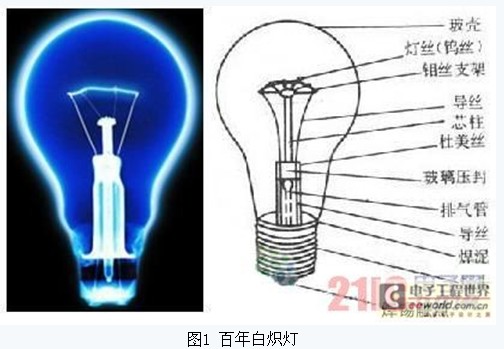
How to design LED lamps as easy to use as incandescent lamps is a major issue for designers of thousands of LED lighting fixtures.
Blu-ray "LED incandescent lamps" may be fine.
The idea of ​​blue light "LED incandescent lamp"
In the spring and summer of 2011, when designing the "blue LED light engine", it was already associated with the design of the blue "LED incandescent lamp".
In view of the fact that the traditional white LED is directly coated with the yellow phosphor on the blue LED, the yellow phosphor is easily denatured under long-term high-temperature scavenging due to the high heat of the white LED, which leads to a change in color rendering index after a long time. difference. In the LED lamp, if the yellow phosphor phosphor is not directly coated on the white LED, the yellow phosphor is dyed on the PVC lamp cover, and the blue LED is kept at a certain distance in the lamp, and the two are superimposed and used. The white light or warm white light effect of LED lamps. Since the yellow phosphorus filter shade is far away from the LED heat source, it will not be denatured due to the long-term high-temperature barbecue of the LED light source, and the CRI (color rendering property) is basically unchanged; the formula of the yellow phosphorus filter shade is adjustable, and the color and color temperature of the light can be With the needs of customers, they can meet the requirements of customization and produce differentiated products.
The blue LED "LED incandescent lamp" follows the structure design of the incandescent lamp to facilitate the transmission of the incandescent lamp usage habits for centuries. The innovation of its connotation is to give LED energy-saving, pollution-free, long-life new technology. The blue HV LEDs are used as the light source, and the yellow phosphor filter shade is added. The mains is converted by AC/DC rectification and constant current driving power, and the output constant current direct current illuminates the blue LED light source. The blue light is filtered by the yellow phosphor filter shade to emit secondary light, so that the "LED incandescent lamp" emits cool white light or warm white light. The working principle is shown in Figure 2.

Blu-ray "LED incandescent lamp" is yellow-phosphor yellow when it is not lit due to yellow phosphorus dyeing or yellow phosphorus-coated PVC lampshade. When it is powered on, it emits cool white or warm white white light. The unlit blue "LED incandescent lamp" is shown in Figure 3. PVC lampshades with yellow phosphorus dyeing or yellow phosphorus spray are key technologies.
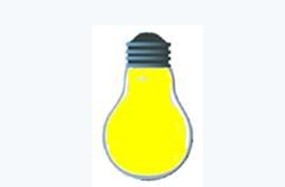
LED light source selection
The blue light "LED incandescent" LED light source selects the preferred blue HV LEDs, which can be directly lit with high voltage direct current, which can simplify the power supply and reduce the power supply cost, and reduce the space occupied by the power supply.
HV LEDs are system-on-a-chip (SOC) or modules that are fabricated directly on silicon wafers during chip production. This is a revolutionary advancement in LED chip manufacturing technology. On a 2 å‹ silicon wafer, thousands of LED dies can be produced at a time, but with common technology and process, the discreteness of each LED parameter is very large, so after the production, the manufacturer needs to measure the parameters one by one, the customer Only the adjacent third gear can be used in one unit (light) to ensure the consistency of the displayed light color. HV LEDs use a new generation of processes and high-level processing technology to make the parameters of thousands of LED dies on the same silicon wafer exactly the same, making it easy to form SOC HV LEDs in the production of chips. For example, the VF50V module has 16 LEDs, all of which have the same electrical parameters (Figure 4). Such blue HV LEDs are easy to use and cost controllable. Another type of COB blue HV LED is a blue LV LED die with a large parametric discrete shape produced by the aforementioned general technology. After the test data, the same parameters are configured together and recombined into one light source body. Due to the need to test, match, screen, and combine LED dies one by one, there are still many parameters that cannot be paired and used in combination. It should be said that the production cost will be high. The operating current of HV LEDs is 20-60 mA, which is relatively small compared to the low-voltage LED requiring 300-700 mA.
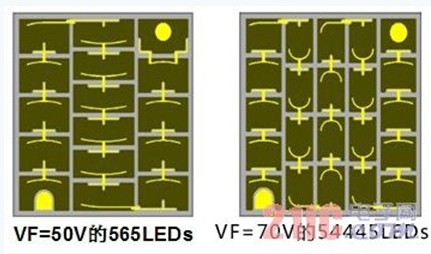
Figure 4 Blu-ray HVLEDs module
Energy Star requires LED bulbs to have an exit angle greater than 270 degrees, so the three-dimensional illumination design of the LED source is the only solution to expand the bulb's illumination angle. Design a copper core pole on the bulb head, and place LED beads or modules around it and at the top, so that the light output can be designed as large as possible to achieve illumination similar to incandescent lamps. The copper core can help the heat dissipation of the LED lamp bead. Due to the limited area of ​​the copper core bar, the blue "LED incandescent lamp" can only be applied to the 3W low-power bulb. Light, it is equivalent to a 25W incandescent lamp. If the sacrificial bulb is close to the light-emitting area of ​​the lamp head and is used to mount the aluminum heat sink, a universal low-voltage blue LED string can be used to design a 5W, 7W blue "LED incandescent lamp". The design of copper light core LED light source distribution can have a variety of options, and depending on the designer, each patent application, the key technology will not be described.
Blu-ray HV LEDs driver power supply design
There are currently three ways to drive blue HV LEDs:
1) Constant current diode (CRD)
A constant current diode (CRD) is a device that can supply a steady current to an LED source bead within a certain voltage variation range, equivalent to a small constant current source or a maximum peak current limiter. A certain current stability is ensured when the grid is small. The application circuit is simple, the cost is low, and the occupied space is small. The performance can only be said to be better than the resistance-resistance step-down circuit. When the small load and the grid voltage fluctuation are not large, the LED constant current requirement can be met. When the grid voltage has large fluctuations, it is difficult to stabilize the output current. The output current of the constant current diode is limited, generally 20-40 mA, but it can meet the requirements of high voltage and small current of HV LED. The current required by HV LED is generally 20-60 mA. The application circuit of CRD is very simple. As shown in Figure 5, when the LED needs less current such as 20mA and the load is lighter, a CRD can be used. When the current is large, such as 30-60mA, it can be used as shown. The CRDs are connected in parallel to increase the current.
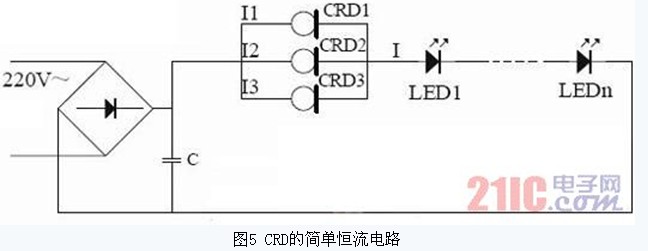
2) High voltage linear constant current source driver chip
Linear drive chips may be one of the better solutions for HV LEDs for constant current drive power. The EXC100 is one of the ideal chips, with very simple application lines and few peripheral components (Figure 6). The EXC100 uses the segmentation conduction technique shown in Figure 7 for the LED load. The EXC100 chip has a built-in high-voltage MOS tube. The application circuit has no transformer and no electrolytic capacitor, and there are few peripheral circuit components. Meet the needs of designing a small space for Blu-ray "LED incandescent lamps". However, the price of EXC100 purchased in China is too expensive, and the cost of producing popular LED lighting fixtures is high, which is unfavorable for large-volume sales of products. Only products with good value for money can pass the world.
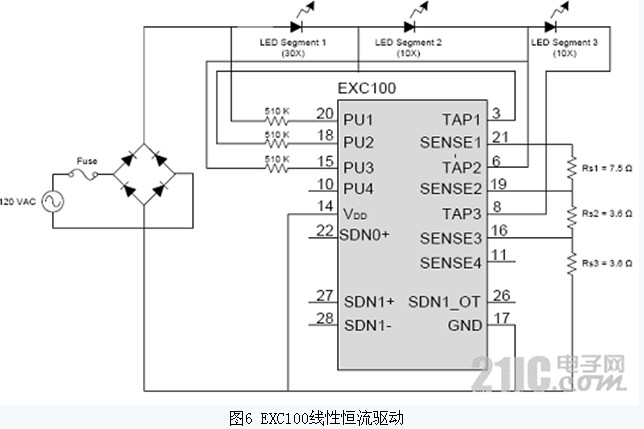
In the past few years, the design level of China's local integrated circuits has been improved, and the products have good cost performance and market competitiveness. The technical solutions and technical support available to downstream manufacturers for production are relatively in place.
BP5118 is a new linear driver power chip designed and produced by local chip design companies for HV LEDs. The BP5118 is a high precision linear constant current LED control chip designed to drive high voltage, low current LED strings or modules powered by utility power. Since the application circuit does not require electrolytic capacitors and magnetic components, the LED driver power supply can achieve small size, long life, and compliance with EMI regulations. The BP5118 uses a patented input voltage sampling and LED drive mechanism to change the number of LEDs that are connected when the input voltage changes, thus increasing the LED illumination time during the entire AC cycle, thereby increasing LED utilization and total output. The number of lumens. In order to adapt to different LED string forward voltage drop or different mains voltage (110V, 220V), the string switching voltage can be flexibly set by the external voltage divider resistor.
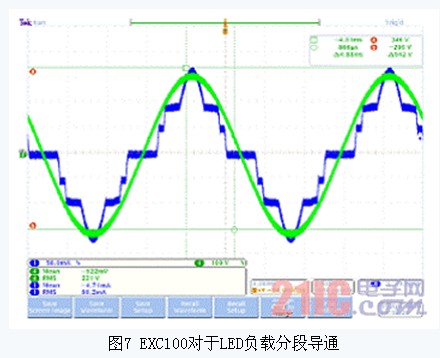
The BP5118 can accurately set the LED current through an external resistor. In the mains input application case of Figure 8, the input voltage: 200Vac ~ 260Vac; 47Hz ~ 63Hz; output load: LED1 134V, LED2 76V, LED3 76V; output average current: 22mA (set maximum current 30mA). If a higher output current is required, the LED requires a heat sink or an external power MOS transistor in parallel. BP5118 has a Thermal Regulation. When the input voltage is too high, or the LED current is too high, this function will reduce the output current, thereby limiting the temperature rise and protecting the LED drive power.
The power output of the BP5118 is externally mounted on the high-voltage MOS tube. It is not packaged in the chip, and the application of the LED lamp bead has a large degree of freedom. This is the biggest difference from the EXC100.
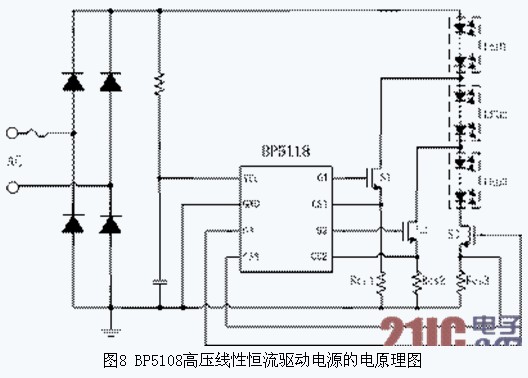
3) High voltage switch constant current source driver chip
There are not many varieties of high-voltage switch constant current source driver chips, and BP2812 is available. BP2812 is suitable for non-isolated drop